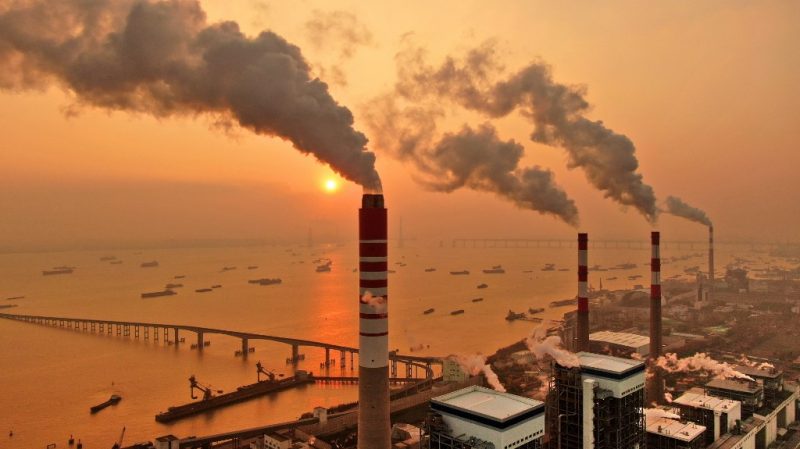(ATF) A series of reports on China’s energy economy for 2021 have been released. These show that the 14th Five-Year Plan will cover a period when the country will undertake an important and historic transition, but significant progress is expected to be made in the move to safe, efficient, clean and low-carbon energy sources.
The latest report on ’14th Five-Year Plan Energy Demand Forecast and Outlook’ shows the country hopes to achieve carbon neutrality by 2060. The transformation of the system will be further strengthened by the ‘smart energy industry’ that is expected to become an important economic growth point, and international energy construction cooperation will be greatly improved.
There are a couple of key facets to this change, which will occur over many years. They are, notably, dumping coal for energy sources such as gas, hydrogen, plus renewables such as solar and wind power.
China is also looking to adopt a carbon pricing market, which is described by Wikipedia as “the method widely agreed to be the most efficient way for nations to reduce global warming emissions”. It is generally done by applying a cost to carbon pollution to encourage polluters to reduce the amount of greenhouse gases they emit – via either a carbon tax or a requirement to purchase permits to emit, generally known as carbon emissions trading. More details are due to emerge on that in the near future.
Wei Yiming, director of the Energy and Environmental Policy Research Centre, who is vice-president of Beijing Institute of Technology told CCTV: “We expect that by 2025, the proportion of non-fossil energy will exceed 20%, and cross-regional and cross-provincial power transactions will be greatly advanced.”
The 2021 energy outlook study is led by Beijing Institute of Technology, and jointly undertaken with the United Nations National Information Centre and the National Climate Centre.
Yu Biying, deputy director of the Energy and Environmental Policy Research Centre, who is a professor at Beijing Institute of Technology, said speeding up the energy system’s transition to low-carbon sources is key to achieving the goal of carbon neutrality, but that alone is not enough. “We also need to undertake adjustment of the industrial structure and accelerate promotion of low-carbon technologies, which will require concerted effort to achieve our goal of carbon neutrality.”
So, China will fully lift access restrictions on foreign investment in coal, oil, gas, power generation, excluding nuclear, as well as the new energy businesses, according to an energy sector white paper released three weeks ago.
China’s energy system reforms must meet the needs of cities, especially mega-cities, which are increasingly driving and leading the country’s growth.
According to data released this week by the Ministry of Housing and Urban-Rural Development, there are currently 30 cities with a population of more than 3 million in urban areas in China, six of which are megacities.
Six cities have over 10 million people
According to the latest yearbook, the urban population of six cities exceeds 10 million, and that includes the four municipalities directly under the Central Government and the two sub-provincial cities of Guangzhou and Shenzhen. Of these, Shanghai exceeds 20 million, and Beijing and Chongqing exceed 15 million.
Chongqing is spread over 82,400 square kilometers, which is equivalent to the area of a medium-sized province. Some urban areas under its jurisdiction are far from the main urban area. The current population of the main urban area of Chongqing is about 9 million.
The 10 cities of Dongguan, Wuhan, Chengdu, Hangzhou, Nanjing, Zhengzhou, Xi’an, Jinan, Shenyang, and Qingdao have urban populations between 5 and 10 million, so they are up and coming megacities, with Jinan recently added to that list.
The Yangtze River Delta City Group has the largest group of cities in China. After Shanghai, the leading city, the second largest city in terms of population in the river delta is Hangzhou, which has surpassed Nanjing, to become the second largest city in the Yangtze River Delta and the entire East China Region.
Driven by the digital economy, Hangzhou has had a rapid influx of population and talent, and the urban population has expanded rapidly, by around 600,000 a year.
Some senior officials are urging greater use of gas and changes to urban energy systems.
Greater use of gas
Zhao Haibin, a representative of Qingdao Municipal People’s Congress, who is party secretary and chairman of Qingdao Energy Group, suggested greater utilisation of natural gas and transforming the power systems for cities.
Depending on their location, Chinese cities have a range of different sources of power, but coal is still the main energy source.
Zhao Haibin said natural gas is a clean energy source and would be preferred for cities to reduce carbon emissions and improve their energy systems. He said the white paper just released on “China’s Energy Development in the New Era” clearly states that China must make every effort to promote clean energy, boost the use of natural gas and renewable energy instead of low-efficiency and high-polluting coal, and promote clean heating for winter in northern regions.
However, judging from the current energy consumption structure in Qingdao, natural gas accounts for only 4% of industrial primary energy, which is lower than the average of 8.3%, and well under Shanghai’s 12% and Shenzhen’s 17.2%. Gas sources were lagging in Qingdao, a port city on the east coast, as there is a need for more gas storage capacity for urban development, so the proportion of ‘clean’ energy heating is low.
However, a strategic cooperation agreement had been signed by Qingdao Energy Group and Sinopec to speed up construction of Dongjiakou LNG terminal, so Qingdao will change from being at the end of the West-East Gas Pipeline to be a source of liquefied natural gas (LNG). That meant it could fully meet the city’s future medium and long-term demands for natural gas.
In China, one of the current goals is to change from “coal to gas” for urban heating. It is estimated that the country will need an an additional 540 million cubic metres of natural gas a year, and that would reduce coal consumption by a million tons annually after gas sources were created.
Clean heating in rural areas
The second part of the energy transformation involves promoting clean heating in rural areas in conjunction with rural revitalization. Relevant departments will introduce policies such as installation subsidies and gas subsidies to simplify the approval process for the construction of gas pipelines in rural areas, and use of natural gas to replace bulk coal, in accordance with local conditions. It is estimated that will cause natural gas consumption to rise by 450 million cubic metres a year, while reducing coal consumption by 300,000 tons a year. It should also slash the incidence of rural soot poisoning.
The third element of the energy plan is to encourage the construction of gas turbine power plants. These are seen as an important way to get a “comprehensive cascade utilization of energy”. At present, gas-fired power generation accounts for up to 18% of China’s natural gas usage.
Officials have been advise to study replacing traditional coal-fired power plants with gas turbine power plants, and to accelerate the completion of the Datang and Huadian gas turbine power plants. These projects are expected to generate an additional 2.5 billion cubic metres of gas a year, while reducing coal consumption by 4.8 million tons annually.
Zhao Haibin believed that the above measures should generate 3.5 billion cubic metres of gas and cut coal consumption by 6.1 million tons annually, thus helping to transform the energy structure in and around Qingdao.
Hydrogen boom in China
The other positive news is, China is going all in to develop a hydrogen production base across the country – from actual hydrogen fuel, batteries, cars, refuelling stations and more. China is going for this technology in a big way.
The Jinneng Science and Technology Project in the northeast is an example of this. This project, which has just had equipment installed, will have a planned annual output of 800 million cubic meters of clean hydrogen energy. It is the lead project at Qingdao Dongjiakou Economic Zone, where the port city has a 100-billion-yuan (US$15.5 billion) green chemical industry cluster. Trial production is due to start at the $3-billion Jinneng project this month. It is expected to generate energy valued at over $4 billion a year (about 70,000 tons and 800 million cubic metres of clean hydrogen energy annually – enough for half a million vehicles). It will also become the largest producer of propane dehydrogenation and polypropylene in China. Two units will each generate 900,000 tons of propane dehydrogenation a year.
In related news, Ridian Xinwen, a new section of qq.com, is a new channel devoted to news related to hydrogen, set up under Tencent. Another report said the Dalian Institute of Chemical Technology had overcome a technical bottleneck for high-precision processing of fuel-cell metal plates.
Dalian Institute of Chemical Physics, the Chinese Academy of Sciences, and Dalian Shentong Mould Co Ltd have carried out industry-university-research cooperation on all-metal bipolar plate fuel-cell technology. They claim to have mastered thin-layer stainless steel metal bipolar plates. The high-precision stamping and forming process has developed a new generation of hydrogen fuel-cell stacks, and the power density has reached an advanced international level, the company said.
Meanwhile, in southeast China, details have been released on the Hainan Provincial Hydrogen Refueling Station Construction Approval Process. This will put Hainan on a fast track for hydrogen cars. All relevant senior government bodies on the island have approved the five-stage process for businesses to set up hydrogen fueling stations. In recent years Hainan has been designated a kind of playboy island, with duty-free shopping, special status for foreign firms and a big focus on tourism. Soon they will be whizzing about in hydrogen-fuelled cars.
But numerous other parts of China are announcing hydrogen projects, from storage to production. One is the Zhongkexinda rare-earth hydrogen-storage alloy project, which has formed a large-scale supply. Situated in the famous Baotou Rare Earth High-tech Zone, Zhongkexinda New Energy Technology Co Ltd has established continuous and stable production of new rare-earth hydrogen storage alloy electrode materials with independent intellectual property rights.
The process and product control system, as well as products are highly valued by many well-known domestic battery power manufacturers. Yanshan University professor Han Shumin said the commissioning of a production line of new rare earth hydrogen-storage alloy electrode materials is an important breakthrough in combining new material R&D and preparation technology with hydrogen energy application. Han Shumin said it pointed to an important direction for the future development of hydrogen energy in China.
NOTE: This report was updated on January 13.
























